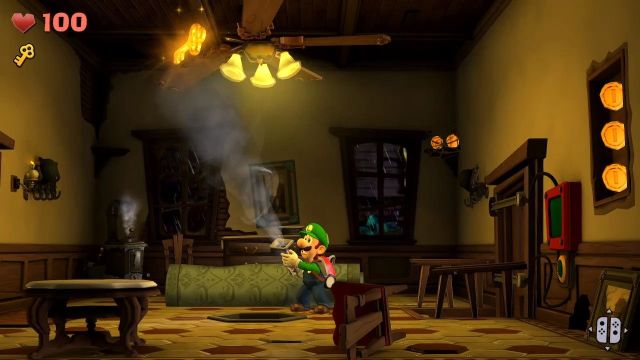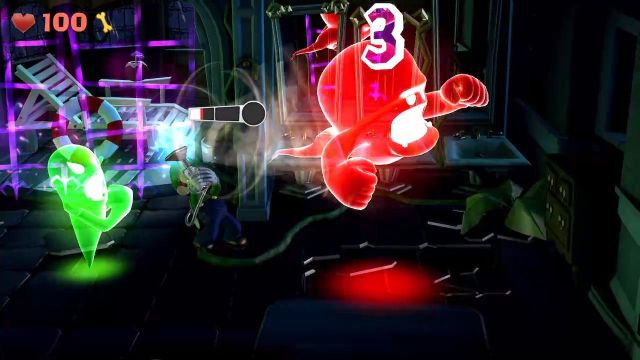Luigi’s Mansion 2 HD is the latest in a long line of remasters Nintendo is pumping out just because it can—not because anyone is crying out for it. The 2013 3DS original (titled Luigi’s Mansion: Dark Moon in the US) was a solid action adventure, but by no means a classic by Nintendo’s standards. And over a decade later, it feels pretty ordinary and a little out of place on the Switch.
While this is certainly a polished, high-quality remaster that greatly enhances the look and feel of the original, it fails to shed the weight of having been designed for far inferior hardware. Moreover, some of the original’s most obvious and easily fixable flaws have been inexplicably retained.
For the uninitiated, the Luigi’s Mansion games are a cartoonish take on the survival horror genre—they’re essentially survival horror without much survival or horror. The silliness of this premise is both Luigi’s Mansion 2 HD’s greatest strength and biggest weakness. As a spoofy tribute to kitschy horror, it works great. But this comes at the expense of any really compelling gameplay hooks.
Taking place in a vacuum

The best example of this clash between flavor and gameplay is the Poltergust 5000, Luigi’s all-in-one ghost-hunting tool. It’s like Luigi ordered a Ghostbusters proton pack from a discount e-commerce platform, and what actually arrived was a vacuum cleaner with shoulder straps. And that’s the joke. And it’s a funny joke. But while the Poltergust 5000 is aesthetically a great concept, it is a cumbersome and ultimately quite limited gameplay device.
Being a vacuum cleaner, the Poltergust’s primary function is to suck. So, used in combination with the Strobulb attachment (an ordinary flashlight taped to the nozzle), Luigi can stun and then suck up ghosts. In other words, it’s a family-friendly ghost-busting weapon. But it’s also a tool for manipulating the environment to solve a variety of puzzles. For example, you might have to blow at a ceiling fan to make it spin, a mechanism that opens a secret door.
The problem with the Poltergust 5000 is that when the surface novelty wears off, it becomes clear that all it really does is over-engineer basic, ordinary interactions that any other game character would perform with their hands. About 90 percent of the time, you’re using it to pull cords or chains or to lift and move things. And you start wishing that you could just walk up to stuff and tap an interact button, rather than going through the time-consuming process of aiming the nozzle, holding down the suck button, moving backward, then yanking on the nozzle.
But if you could do that, the uninspired puzzle design would be laid bare. In general, the solutions are either obvious or you must resort to trial and error to uncover some invisible, or otherwise hidden, path forward. These secret doors and passages fit the aesthetic nicely but don’t make for rewarding gameplay.
And it doesn’t help that the controls system is an awkward hybrid that takes the dual-stick set-up you get in first-person and over-the-shoulder third-person games and wedges it into a game with an old-fashioned fixed camera perspective. You get used to it eventually, but it’s never intuitive.
Luigi’s mission

While the first Luigi’s Mansion on the GameCube adopted an open-world approach, Luigi’s Mansion 2 is broken up into missions with an average duration of about 20 minutes (at least on your first attempt). This change made sense on the 3DS given that handheld gaming is best-suited to self-contained bursts of action, but on the Switch, the flaws in this structure are vividly exposed.
The fact that you get teleported out of the mansion for a debriefing after completing every major objective slows the game’s pace horribly and breaks the sense of immersion and exploration. You want to feel that you’re progressing deeper into this spooky environment as it unfolds out of the darkness ahead, but the game just won’t let you.
And when you get teleported back in for the next mission, it’s usually to the exact same start point as that of the last mission, and you have to negotiate the same rooms all over again, usually with only subtle differences. This is due to another limitation of the 3DS—that it didn’t have the capacity for a lot of different environments. So Luigi’s Mansion 2 HD repurposes the same environments repeatedly. Sometimes it’s quite cleverly done—for example, during one mission you might fill a room with water or sand, making it a quite different environment for the next mission—but no amount of smoke and mirrors can prevent the game from feeling repetitive. It was forgivable on the 3DS, but on the Switch, it feels like a bit of a dupe.
Oh, and just as in the original game, there are no checkpoints during missions, meaning that if you “die,” you have to restart the mission. This can mean losing as much as half an hour of progress, which sucks as hard as the Poltergust. Surely, a mid-mission checkpoint or two wouldn’t have been hard to implement?
Solid, but un-spook-tacular

So, in terms of its concept and flavor, Luigi’s Mansion 2 HD is spooky, atmospheric, and entertaining, and made even more so by the quality of its HD upgrade, but as a gameplay experience, it’s mostly very ordinary. It’s solid, with only a few really annoying bits, but there are none of the magical moments or ingenious hooks you’d expect from a top-drawer Nintendo product.
Fans of the original looking for a nostalgia fix and loyal Nintendo completists won’t be disappointed. But Luigi’s Mansion 2 HD definitely isn’t Nintendo at its inventive best. If it were, it would have Mario’s name on the front.
- A polished, high-quality reskin
- Atmospheric and characterful
- Awkward controls
- Slow, repetitive pace
- No real gameplay hooks
- Some annoying bits




